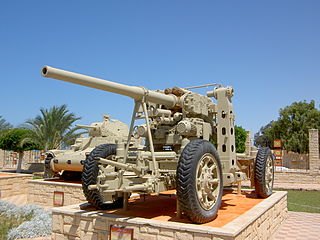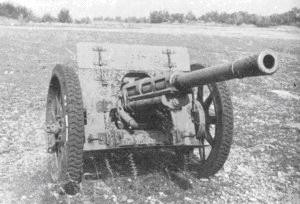
An assault gun is a type of armored infantry support vehicle and self-propelled artillery, mounting a infantry support gun on a protected self-propelled chassis, intended for providing infantry with heavy direct fire support during engagement, especially against other infantry or fortified positions, secondarily also giving some armored protection and anti-armor capability.

A tank destroyer, tank hunter or tank killer is a type of armoured fighting vehicle, predominantly intended for anti-tank duties. They are typically armed with a direct fire artillery gun, also known as a self-propelled anti-tank gun, or missile launcher, also called an anti-tank missile carrier. The vehicles are designed specifically to engage and destroy enemy tanks, often with limited operational capacities.

The L6/40 was a light tank used by the Italian army from 1940 through World War II. It was designed by Ansaldo as an export product, and was adopted by the Italian Army when officials learned of the design and expressed interest. It was the main tank employed by the Italian forces fighting on the Eastern Front alongside the L6/40-based Semovente 47/32 self-propelled gun. L6/40s were also used in the North African campaign.

The Obice da 75/18 modello 34 was an Italian artillery piece used during World War II.

The Carro Armato M13/40 was an Italian World War II tank designed to replace the M11/39 in the Royal Italian Army at the start of World War II. It was the primary tank used by the Italians throughout the war. The design was influenced by the British Vickers 6-Ton and was based on the modified chassis of the earlier M11/39. Production of the M11/39 was cut short in order to get the M13/40 into production. The name refers to "M" for Medio (medium) according to the Italian tank weight standards at the time, 13 tonnes was the scheduled weight and 1940 the initial year of production.

The Carro Armato M15/42 was the last Italian medium tank produced during World War II. It was based on the earlier M13/40 and M14/41 medium tanks, and was built with the lessons from the North African Campaign in mind. The tank was meant to be a stopgap until the heavier P26/40 tank could be produced in numbers. It did not serve in North Africa, the theatre in which it was intended to operate, but served in Italy and in Yugoslavia with the German Wehrmacht.

The P 26/40 was an Italian World War II heavy tank. It was armed with a 75 mm gun and an 8 mm Breda machine gun, plus another optional machine gun in an anti-aircraft mount. Design had started in 1940 but very few had been built by the time Italy signed the armistice with the Allies in September 1943 and the few produced afterwards were used by the Germans.

The Cannone da 90/53 was an Italian-designed cannon used both in an anti-aircraft role and as an anti-tank gun during World War II. It was one of the most successful anti-aircraft guns to see service during the conflict. The naval version of the gun was mounted on Italian battleships of the Littorio-class and the Andrea Doria-class.

The Cannone da 75/46 C.A. modello 34 was a mobile Italian anti-aircraft gun used during World War II. The designation means it had a caliber of 75 mm, the barrel was 46 caliber-lengths long and it was accepted in service in 1934.

The Cannone da 75/32 modello 37 was an Italian field gun used during World War II. The designation indicates that the gun had a 75 mm caliber, the barrel was 32 caliber-lengths long and it was accepted for service in 1937.

The Semovente da 90/53 was an Italian self-propelled gun and tank destroyer, used by the Italian and German Armies during World War II.

The Ansaldo 105/25 M43, also known as Semovente 105/25, was an Italian self-propelled gun used during World War II and designed by Ansaldo. It was the most powerful self-propelled gun built by Italy in numbers during World War II.

The Royal Italian Army, participated in World War II on the side of the Axis Powers on 1940. The Royal Italian Army notably fought at the Balkans, Western Alps, North and East Africa and Russia until its defeat in 1943 by the Allies. The Royal Italian Army was then turned into the Italian Co-Belligerent Army fighting alongside the Allies while some Italian forces joined the Germans as the National Republican Army on the Italian Social Republic in Northern Italy.

The Cannone da 149/40 was a heavy gun which served with Italy during World War II. It was intended to replace the obsolete Cannone da 149/35 A, but the small numbers produced prevented that. By 1940 orders had been placed for 590, but only 51 were in service at the end of September 1941. Weapons captured by the Germans after the Italian surrender in 1943 were put into service as the 15 cm K 408(i). Ansaldo produced a batch of twelve for the Germans in April 1944.

The Semovente da 75/18 was an Italian self-propelled gun of the Second World War. It was built by mounting the 75 mm Obice da 75/18 modello 34 mountain gun on the chassis of a M13/40, M14/41 or M15/42 tank. The first 60 were built using the M13/40 chassis and a subsequent 162 were built on the M14/41 chassis from 1941 to 1943. A total of 190 were built utilizing the M42 chassis before the armistice and an additional 55 were built afterwards. The Semovente da 75/18 was intended to be an interim vehicle until the heavier P40 tank could be available.

The Semovente da 75/46 was an Italian tank destroyer in service during the late World War II. A derivative of the Semovente da 105/25 self-propelled gun, it was produced in very few numbers and used by Nazi Germany in the Italian campaign.

Tanks have been employed by the military forces in Italy since their first use in World War I. They have had continued use in wars after and are still used through the modern day. The C1 Ariete is the current main battle tank of the Italian Army.


















